At this point in our story it’s still the spring of 1934. Before renting Shirley Temple out to Paramount to become a star, Fox frittered her away in one more pointless bit in Now I’ll Tell. Actually, the picture’s full title on screen was “Now I’ll Tell” by Mrs. Arnold Rothstein, and as that suggests, it purported to be the inside dope on the high-flying life and mysterious death of Mrs. Rothstein’s deceased husband, the gangster/gambler who fixed the 1919 World Series, was shot in November 1928 (apparently for welshing on a poker debt), and died two days later refusing to name his killer. Names were changed to protect the guilty, so Spencer Tracy starred as “Murray Golden”, with Helen Twelvetrees as his saintly, noble wife (Mrs. Rothstein wrote the story, remember!), and with Rothstein’s many mistresses combined into one person and played by 18-year-old Alice Faye.
Shirley’s role was an inch or two better than in Change of Heart: 42 seconds on screen and a whopping five lines of dialogue (to wit: “And we saw a cow there, too!”, “Does a black cow make black milk?”, “Good night”, and “Good night, Daddy” — twice). Publicity poses like this one may have led Shirley to misremember her role as that of Tracy’s daughter; in fact, she played the daughter of Tommy Doran (Henry O’Neill), a boyhood chum of Golden’s who grows up to be a police detective — on the other side of the law from his old pal. A decent enough gangland melodrama, Now I’ll Tell hit screens one week after Little Miss Marker, and could only have underscored Fox’s cluelessness.
(A side note: While Fox quickly learned to value Shirley, they never did know what they had in Spencer Tracy. They put him in 18 pictures in five years, usually as mugs and lummoxes, with the occasional loan-out here and there. Gradually he built a reputation as one of the best actors in town, but Fox kept wasting him on parts you could practically train a gorilla to play. Eventually they let him slip through their fingers into a contract with MGM in 1935. Within two years at Metro, Spence had snagged his first Oscar nomination; in the following two years he got his second and third, winning both times.)
After Now I’ll Tell, however, Shirley’s days of Poverty Row shorts, four-line bits and uncredited walk-ons were finally behind her. For her next picture, she got top billing at last from her home studio, and just to remind audiences where they’d seen this kid before, Fox changed the title to…
Baby Take a Bow
(released June 30, 1934)
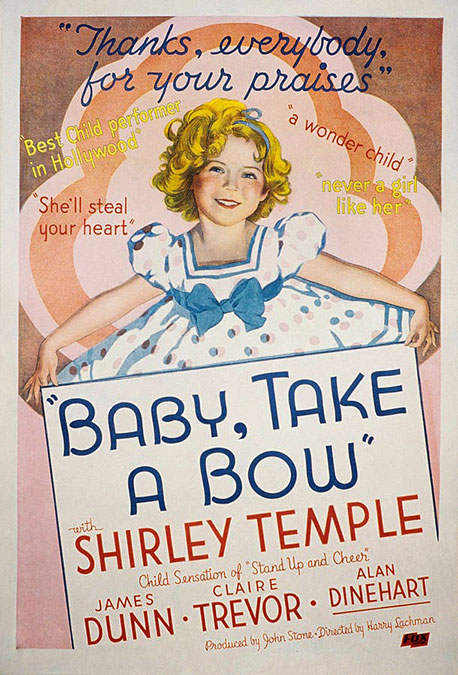
First, an explanation of a trivial point, just so you don’t suspect sloppy copy editing here at Cinedrome. The title of Jay Gorney and Lew Brown’s song “Baby, Take a Bow” has a comma, and the comma appears in this and some other posters, ads and lobby cards for the movie. But it’s not on the picture’s main title card as it appears on screen. Therefore, I’ll be using the comma when referring to the song, but not using it when I’m referring to the movie. Got it?
Anyhow, “Baby, Take a Bow” isn’t in Baby Take a Bow — except as a line of dialogue spoken by James Dunn (once again playing Shirley’s father); but more of that later.
There’s an intriguing mystery about the source material for
Baby Take a Bow that’s worth going into before we get to Shirley’s version of it. It was originally a play by James P. Judge titled
Square Crooks that ran on Broadway for 150 performances in 1926. That was a pretty decent run in those days, especially for a one-set play with a cast of nine, so
Square Crooks probably turned a profit for its investors. In any case, it was bought by Fox and filmed as a silent in 1928.
Robert Armstrong and John Mack Brown played two ex-cons trying to go straight who fall under suspicion when a crony from their criminal days steals a pearl necklace from their wealthy employer. The thief tries to get the two to fence the pearls but they refuse. Complications arise when the thief, sensing the cops hot on his trail, stashes the necklace with Armstrong’s unsuspecting little girl, who thinks it’s a birthday present. What follows is a comic round of button-button-who’s-got-the-button as the thief tries to retrieve the pearls; the heroes try to return them to their boss; an implacable insurance detective seeks to get the goods on the heroes, whom he suspects of the theft; and the little girl thinks it’s all a game of hide-and-seek.
The mystery I mentioned arises from a reading of Variety’s review of
Square Crooks. The reviewer “Mori” praised it lightly as a “moderately interesting” B programmer (it ran only 60 minutes), but added, “Only chance with a story of this kind was to build a central character. But here five different people and a juvenile player divide interest, with the baby drawing first honors.” Mori didn’t identify the “baby”, and neither does the picture’s
IMDb listing or the listing for the original play on the
Internet Broadway Database (where the credits are admittedly incomplete). So unless a print of
Square Crooks survives in the Fox vault (which, for a silent that came out during the hectic talkie revolution, is highly doubtful), the name of the little girl who Mori thought stole the show is probably lost forever to history.
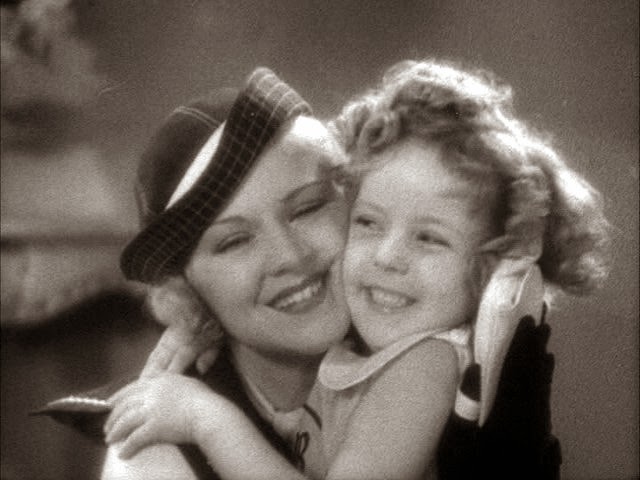
Be that as it may, we certainly know who played the kid in the sound remake. Shirley is shown here with Claire Trevor, who plays her mother and James Dunn’s wife. Trevor is younger and softer in Baby Take a Bow than we remember her from her better-known performances — Stagecoach; Key Largo; The High and the Mighty; Murder, My Sweet — she could almost pass for Ginger Rogers here.
Baby Take a Bow opens as Eddie Ellison (Dunn) is released from Sing Sing, promising to go straight. His girl Kay (Trevor) meets him at the gate, with continuing tickets for them to Niagra Falls for a justice of the peace wedding and honeymoon. At the same time we meet insurance investigator Welch (Alan Dinehart in an interesting performance), a tinhorn Javert who bluffly pals around with the men of various police forces — and tries in vain to make time with Kay. Everybody, especially Kay, makes it clear that they don’t like him, but Welch remains oblivious, blithely carrying on as if he’s one of the guys. Six years later, when Eddie and Kay have built a happy home with their daughter Shirley (star and character share the given name), it will be Welch who tries to hound Eddie and his pal Larry (Ray Walker) back into prison.

Unlike Little Miss Marker over at Paramount, Baby Take a Bow gives ample evidence of having been thrown together in haste. It begins as melodrama, then segues into farce as Dunn, Walker, Trevor, Shirley and Ralf Harolde as the thief chase the pearl necklace up, down, back and forth in the Ellisons’ apartment house. Then for the last reel it shifts back to melodrama as Harolde finally nabs the pearls and kidnaps Shirley to use as a shield in making good his escape. All ends happily, with the thief in custody, the pearls returned, and the heroes exonerated. Even the meddling Welch gets his just deserts.
Director Harry Lachman was evidently too hurried — or too clumsy — to negotiate these shifts in tone; the comedy scenes fall particularly flat. The picture’s chief pleasure, predictably, is Shirley herself. But there are other small ones along the way, such as this, a tossed-off scene in which Kay and Shirley go through some dining-room calisthenics while listening to an exercise progam on the radio. Mother and daughter (and the actresses playing them) are clearly having fun, and it’s contagious.
Also among those pleasures is another song and dance number for Shirley and James Dunn — the one touch of music in the picture. The song is “On Account-a I Love You” by Bud Green and Sam H. Stept, performed by father and daughter at a rooftop birthday party for Shirley in which she shows off the new ballet dress Mommy and Daddy have given her. Again, the haste of the production is evident in the under-rehearsed hoofing (dance director Sammy Lee apparently didn’t even have the few days he was allotted for “Baby, Take a Bow” in Stand Up and Cheer!). Still, the number is a highlight and worth sharing. At the end of the song, you’ll see Dunn turn to Shirley and say, “C’mon, baby, take a bow,” thus justifying the picture’s title (again, the YouTube clip is colorized, and again I ask your indulgence):
Variety’s reviewer “Kauf” pegged Baby Take a Bow exactly: “Without Shirley Temple this might have been a pretty obvious and silly melodrama, but it has Shirley Temple so it can go down on the books as a neat and sure b.o. (box office) hit, especially for the family trade.” (It’s a pity Mori couldn’t have reviewed it; it would be interesting to have him compare it to Square Crooks — assuming he even remembered a six-year-old silent B picture as late as 1934.) Meanwhile, back east at the New York Times, the anonymous reviewer sounded the first notes of praise mixed with highbrow condescension that would increase in some quarters in coming years (and would lead eventually to a successful libel suit against novelist Graham Greene and the British magazine Night and Day):
Little Shirley Temple continues in her new film at the Roxy to be the nation’s best-liked babykins. A miracle of spontaneity, Shirley successfully conceals the illusion of sideline coaching which, in the ordinary child genius, produces homicidal impulses in those old fussbudgets who lack the proper admiration for cute kiddies.
Then, in the next sentence, the reviewer gave credit where it was due: “In ‘Baby, Take a Bow,’ she tucks the picture under her little arm and toddles off with it.” (And by the way, it’s worth noting that “nation’s best-liked babykins” line. This, mind you, on the strength of only Stand Up and Cheer! and — especially — Little Miss Marker.)
Before embarking on her next picture at Fox, Shirley was shuttled back to Paramount for another loan-out:
Now and Forever
(released August 31, 1934)

Shirley’s billing on Now and Forever was again above the title, but third this time. Still, when you’re billed third after Gary Cooper and Carole Lombard, you’ve really got no kick coming. (On screen she gets an “and”: “And SHIRLEY TEMPLE”.) Even more significantly, the music under the opening titles is an instrumental rendition of “Laugh, You Son of a Gun” — reminding audiences of Little Miss Marker the way Baby Take a Bow had reminded them of Stand Up and Cheer!
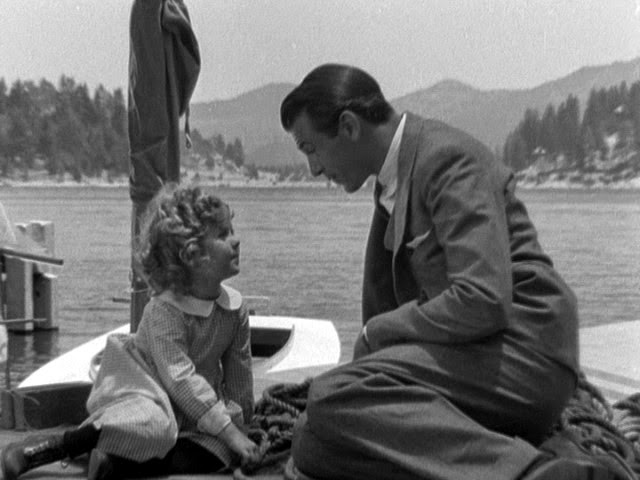
Now and Forever also reunited Shirley with director Henry Hathaway, who had presided over her near-death experience with a pony on To the Last Man. In this picture, Gary Cooper plays Jerry Day, a globe-trotting confidence man, with Carole Lombard as Toni, his accomplice and companion. In the credits she’s identified as “Toni Day”, but the script makes it pretty clear that they’re not married; in the first scene he tells her, “I told you I was married,” not, “was married before.” Anyhow, Jerry was married, but when his wife died, he left his infant daughter with her wealthy, disapproving family; he figures the child must be five or six now. When he and Toni find themselves out of cash, he proposes to go to his stuffed-shirt brother-in-law and sell his parental rights for $75,000. But one brief visit with little Penny (Shirley), who naturally doesn’t know him, changes his mind. He reveals himself to her and takes her with him while his brother-in-law fumes and blusters.
First stop, New York, where Jerry runs a scam on a Mr. Felix Evans (Sir Guy Standing) for $5,000 in a phony mining deal. Then it’s bon voyage for Europe to meet Toni in Paris. Their ship is barely out of port before they meet Mr. Evans strolling the deck. Jerry manages to stammer out that he was suddenly called away to Europe, and Evans gives him a smooth, knowing smirk. “Quite a coincidence, Mr. Day. Because the same thing happened to me.” And Evans calmly wishes him a good day.
Jerry and Penny join Toni in Paris, where, after a little jealous tension, Toni and Penny bond with one another. Toni has an uneasy conscience over bringing Penny into the lifestyle she and Jerry have adopted, and in his way, so does he. He tries to settle down into an honest job in Paris, but his and Toni’s rich tastes are his undoing. Then the sinister Mr. Evans reenters his life. Evans has his eye on the jewels of Mrs. J.H.P. Crane (Charlotte Granville), a dowager widow who has taken a shine to Penny, and he wants Jerry to help him lay hands on them.
That’s really as far as we need to go with Now and Forever because…well, frankly, despite the nostalgic value of Cooper, Lombard and Temple in the same picture, it’s a bit of a dud. The script by Vincent Lawrence and Sylvia Thalberg (sister of Irving) is as bland and pointless as the title, and this sort of ersatz Ernst Lubitsch was never director Hathaway’s strong suit. Shirley sings one song, “The World Owes Me a Living” from the then-current Disney Silly Symphony The Grasshopper and the Ants, which serves as Jerry’s unofficial theme song (he’s whistling it when he first meets Penny). But even that’s a cheat; Hathaway cuts away for a long scene of Jerry stealing an emerald necklace and stashing it in his daughter’s teddy bear, with Penny’s voice barely audible in a distant room of the old lady’s mansion. Now and Forever is really only memorable for two things. One is Shirley’s recollection of the fun of working with Carole Lombard (“If she really employed bawdy humor and truck-driver expletives, it was never within my hearing. Wherever she went she seemed to wear a halo of crystalline happiness.”).
The other thing is a scene in which Penny learns that her father is a jewel thief and has lied to her about it. On the set that day, just before the cameras rolled, some blabbermouth inadvertently spilled the beans about Dorothy Dell’s gruesome death. The tears we see in that scene aren’t Penny’s disillusionment with her father; they’re Shirley’s genuine grief at the loss of her friend from Little Miss Marker.
After this second excursion to Paramount, Shirley returned to Fox for her next job, the first real “Shirley Temple picture” — in the sense that it was tailor-made just for her — with the song that, as she put it, would stick to her “like lifelong glue”. Except for a famous near-miss several years later (which I’ll get to in good time), there would be no more talk about loaning her out.
 I’m going to pass over Dimples as quickly as duty will allow because, like Now and Forever, it’s a bit of a dud, and for similar reasons. The setting is New York in 1850; Shirley plays Chalvia Dolores Appleby, known by all as “Dimples”. As in Now and Forever, she’s the child of an unregenerate grifter, only this time it’s not her father but her grandfather, “Professor” Eustace Appleby (Frank Morgan). The Professor calls himself a music teacher of “the Pianoforte, the Bugle, the Melodion, the Drum, also Bird Calls”, but mainly he just stands in the crowd shilling while Dimples and his other “students” sing, dance and play their instruments in the streets. Then he starts the contributions when Dimples passes the hat and, while other bystanders are dropping coins in, he works the crowd picking pockets. In another similarity to Now and Forever, Dimples catches the eye of wealthy old Mrs. Drew (Helen Westley), who wants to lift her out of the Bowery poverty in which she lives with the Professor. At the same time, Mrs. Drew becomes estranged from her nephew Allen (Robert Kent) when he becomes romantically involved with (gasp!) an actress whom he decides to star in a production of Uncle Tom’s Cabin — in which he later hires Dimples to play Little Eva.
I’m going to pass over Dimples as quickly as duty will allow because, like Now and Forever, it’s a bit of a dud, and for similar reasons. The setting is New York in 1850; Shirley plays Chalvia Dolores Appleby, known by all as “Dimples”. As in Now and Forever, she’s the child of an unregenerate grifter, only this time it’s not her father but her grandfather, “Professor” Eustace Appleby (Frank Morgan). The Professor calls himself a music teacher of “the Pianoforte, the Bugle, the Melodion, the Drum, also Bird Calls”, but mainly he just stands in the crowd shilling while Dimples and his other “students” sing, dance and play their instruments in the streets. Then he starts the contributions when Dimples passes the hat and, while other bystanders are dropping coins in, he works the crowd picking pockets. In another similarity to Now and Forever, Dimples catches the eye of wealthy old Mrs. Drew (Helen Westley), who wants to lift her out of the Bowery poverty in which she lives with the Professor. At the same time, Mrs. Drew becomes estranged from her nephew Allen (Robert Kent) when he becomes romantically involved with (gasp!) an actress whom he decides to star in a production of Uncle Tom’s Cabin — in which he later hires Dimples to play Little Eva. In Child Star Shirley remembered Frank Morgan’s tireless efforts to upstage her and steal focus during their scenes — fiddling with his cuffs, flourishing his handkerchief, placing his stovepipe hat on a table between her and the camera so that she couldn’t be in the shot without stepping off her mark and out of the light. (“Both of us knew perfectly well what he was doing. There was no way I could cope, short of biting at his fingers.”) Director William A. Seiter was on to Morgan’s tricks too; in this scene, where Dimples sings “Picture Me Without You” (one of four pleasantly forgettable songs provided by Jimmy McHugh and Ted Koehler), Seiter made Morgan sit in a chair with his back to the camera. (“When this picture is over,” cracked producer Nunnally Johnson, “either Shirley will have acquired a taste for Scotch whiskey or Frank will come out with curls.”)
In Child Star Shirley remembered Frank Morgan’s tireless efforts to upstage her and steal focus during their scenes — fiddling with his cuffs, flourishing his handkerchief, placing his stovepipe hat on a table between her and the camera so that she couldn’t be in the shot without stepping off her mark and out of the light. (“Both of us knew perfectly well what he was doing. There was no way I could cope, short of biting at his fingers.”) Director William A. Seiter was on to Morgan’s tricks too; in this scene, where Dimples sings “Picture Me Without You” (one of four pleasantly forgettable songs provided by Jimmy McHugh and Ted Koehler), Seiter made Morgan sit in a chair with his back to the camera. (“When this picture is over,” cracked producer Nunnally Johnson, “either Shirley will have acquired a taste for Scotch whiskey or Frank will come out with curls.”)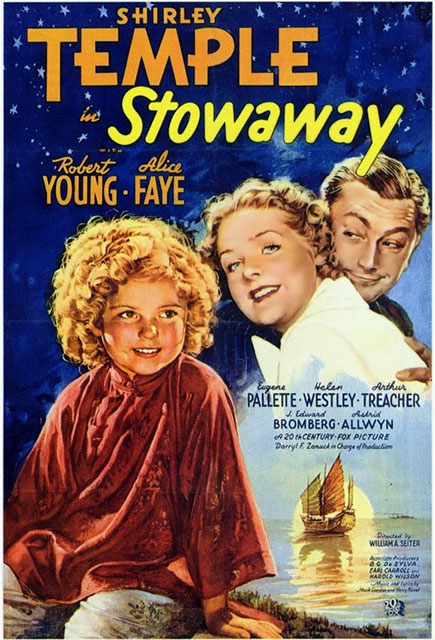 Stowaway gave Shirley an exotic setting, a story that didn’t require her to carry the show all by herself, and cast-mates who were strong enough to share the load. Shirley played Barbara Stewart, nicknamed “Ching-Ching”, the orphaned daughter of missionaries in Sanchow, China. At the approach of bandits from the hills, she’s about to be orphaned again — or worse — because her guardians the Kruikshanks (also missionaries) refuse to flee from the approaching marauders. Defying them, the wise local magistrate Sun Lo (Philip Ahn) spirits Ching-Ching away with a boatman to Shanghai.
Stowaway gave Shirley an exotic setting, a story that didn’t require her to carry the show all by herself, and cast-mates who were strong enough to share the load. Shirley played Barbara Stewart, nicknamed “Ching-Ching”, the orphaned daughter of missionaries in Sanchow, China. At the approach of bandits from the hills, she’s about to be orphaned again — or worse — because her guardians the Kruikshanks (also missionaries) refuse to flee from the approaching marauders. Defying them, the wise local magistrate Sun Lo (Philip Ahn) spirits Ching-Ching away with a boatman to Shanghai.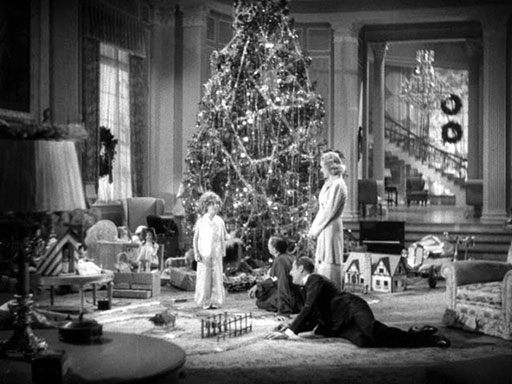 Alice also sang “One Never Knows, Does One?”, another one by Gordon and Revel, this time with no little-girl version for Shirley. Then Shirley closed out the show with “That’s What I Want for Christmas”, written by the uncredited Gerald Marks and Irving Caesar. This last number comes at the very end, after the story has been brought to a satisfying conclusion, and it plays almost like a curtain-call encore. Evidently it was added at the last minute to exploit the movie’s holiday engagement at New York’s Roxy picture palace (it didn’t sift down to the rest of the country until after the turn of 1937).
Alice also sang “One Never Knows, Does One?”, another one by Gordon and Revel, this time with no little-girl version for Shirley. Then Shirley closed out the show with “That’s What I Want for Christmas”, written by the uncredited Gerald Marks and Irving Caesar. This last number comes at the very end, after the story has been brought to a satisfying conclusion, and it plays almost like a curtain-call encore. Evidently it was added at the last minute to exploit the movie’s holiday engagement at New York’s Roxy picture palace (it didn’t sift down to the rest of the country until after the turn of 1937).

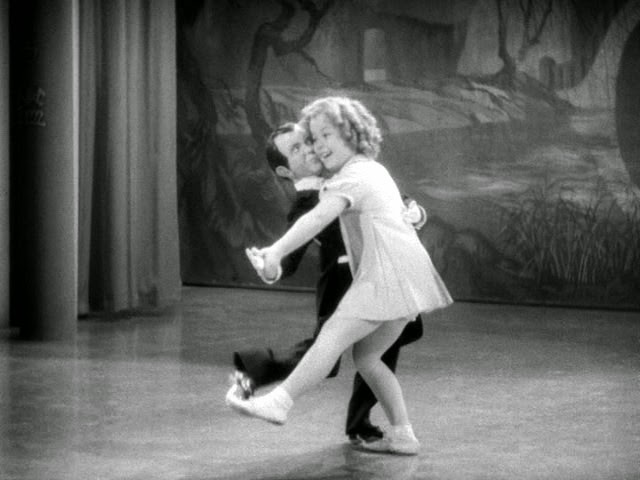
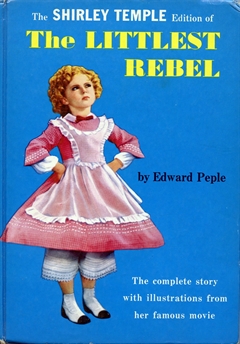
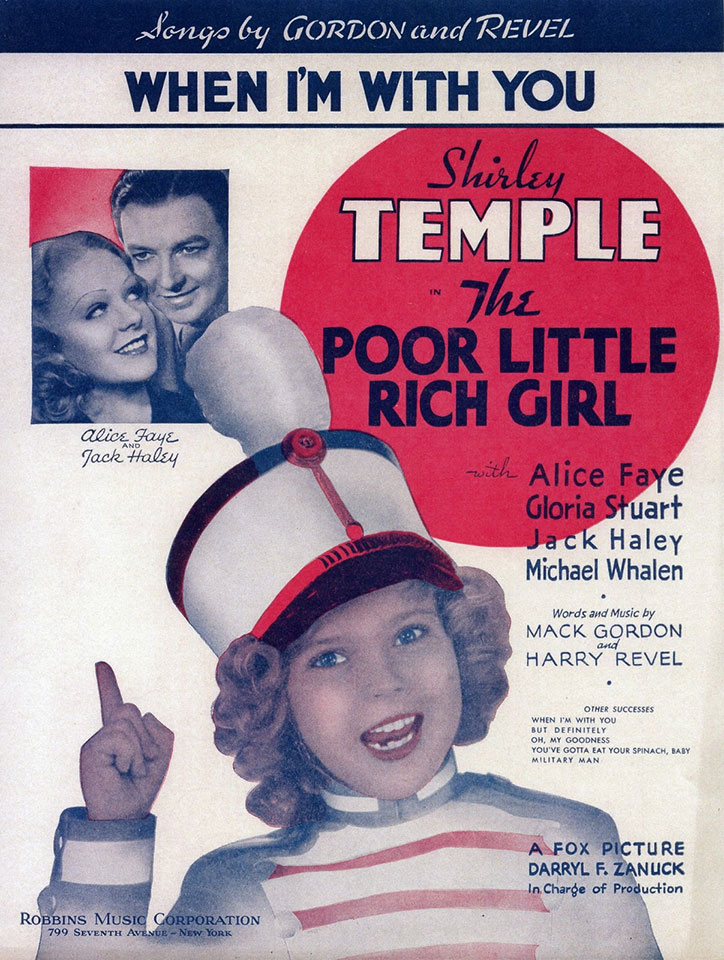 Don’t be misled by the picture’s title as it appears on the cover of the sheet music below (and on several of the posters and lobby cards); the title was Poor Little Rich Girl, with no “The“. Poor Little Rich Girl has a distinction it shares with Our Little Girl: They are the only two pictures from Shirley’s reign as Fox’s box-office queen (before and after the merger) that are not available on DVD; both can be seen only on out-of-print colorized VHS tapes.
Don’t be misled by the picture’s title as it appears on the cover of the sheet music below (and on several of the posters and lobby cards); the title was Poor Little Rich Girl, with no “The“. Poor Little Rich Girl has a distinction it shares with Our Little Girl: They are the only two pictures from Shirley’s reign as Fox’s box-office queen (before and after the merger) that are not available on DVD; both can be seen only on out-of-print colorized VHS tapes.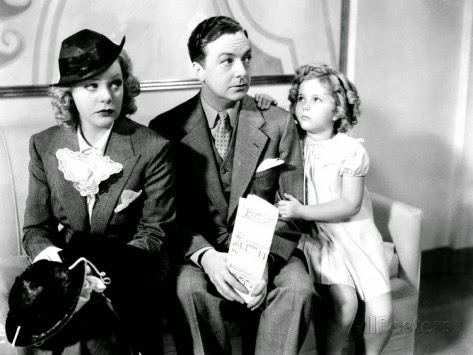
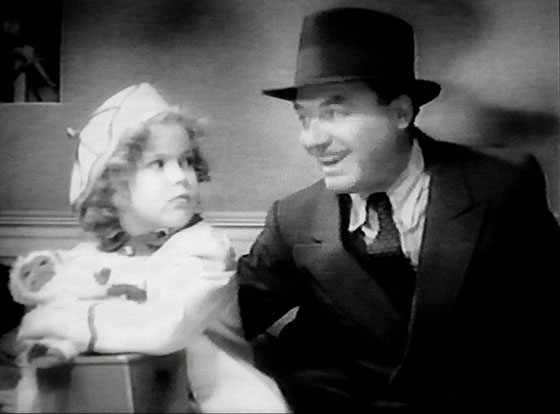
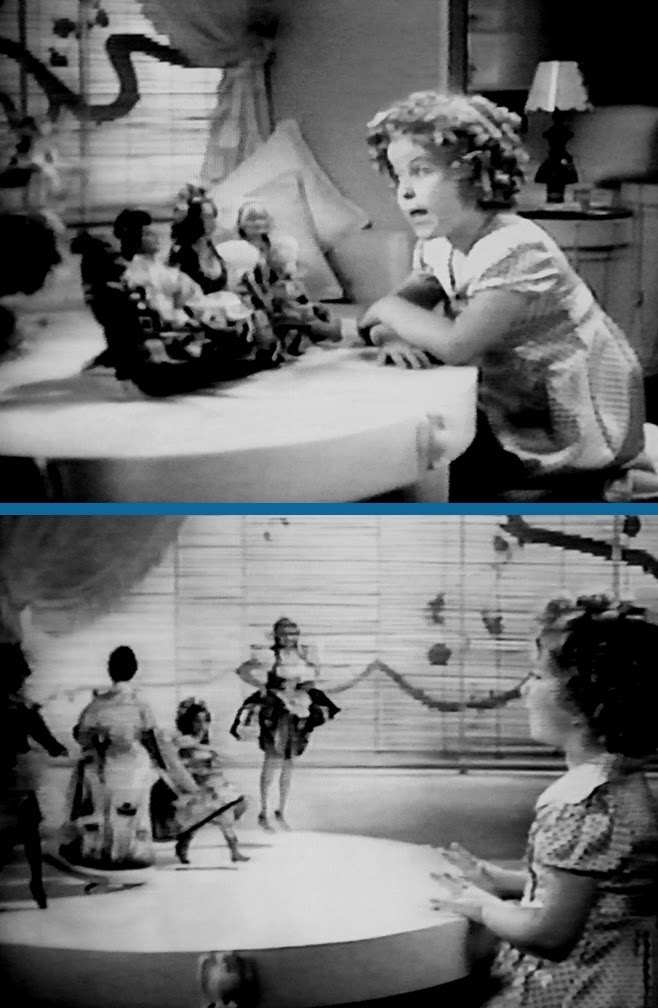
 The creation of 20th Century Fox was announced as a merger, but it was really a friendly takeover. Darryl Zanuck (former production head at Warner Bros.) and Joseph Schenck (former president of United Artists) had formed 20th Century Pictures in 1933 as an independent concern, renting equipment and studio-and-office space from UA. In two years 20th Century had produced 18 pictures, all but one of which had made money, and several of which had made quite a lot: Folies Bergere de Paris, The House of Rothschild, The Affairs of Cellini, The Call of the Wild, Les Miserables, etc. But Zanuck got his hackles up when UA wouldn’t sell any of its stock to 20th Century, and he started looking around.
The creation of 20th Century Fox was announced as a merger, but it was really a friendly takeover. Darryl Zanuck (former production head at Warner Bros.) and Joseph Schenck (former president of United Artists) had formed 20th Century Pictures in 1933 as an independent concern, renting equipment and studio-and-office space from UA. In two years 20th Century had produced 18 pictures, all but one of which had made money, and several of which had made quite a lot: Folies Bergere de Paris, The House of Rothschild, The Affairs of Cellini, The Call of the Wild, Les Miserables, etc. But Zanuck got his hackles up when UA wouldn’t sell any of its stock to 20th Century, and he started looking around.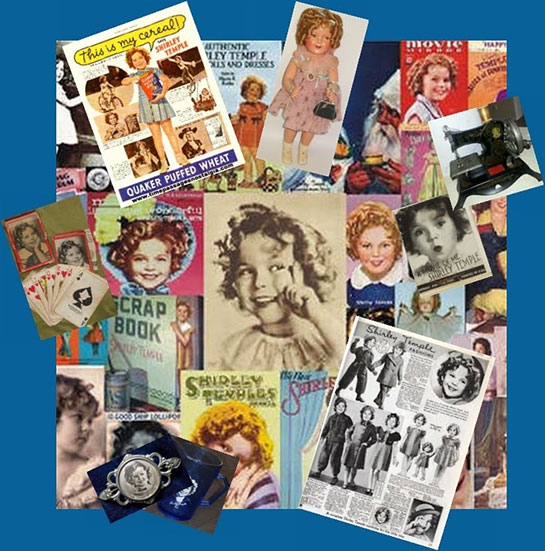
 Shirley’s first picture to bear the new 20th Century Fox logo (with its now-famous fanfare) had been in the works before the merger, as the cover of this sheet music suggests. The ostensible source was a play by Edward Peple that ran for 55 performances on Broadway in the winter of 1911-12 before embarking on a long and prosperous tour, making a child star of the ill-fated
Shirley’s first picture to bear the new 20th Century Fox logo (with its now-famous fanfare) had been in the works before the merger, as the cover of this sheet music suggests. The ostensible source was a play by Edward Peple that ran for 55 performances on Broadway in the winter of 1911-12 before embarking on a long and prosperous tour, making a child star of the ill-fated  The Littlest Rebel was aimed at duplicating the success of The Little Colonel; in fact, it surpassed it, and was one of Shirley’s smoothest pictures. The only thing that really dates it today — and it dates it terribly — is the racial attitude I mentioned in my notes on The Little Colonel. That attitude is even more glaring and uncomfortable in The Littlest Rebel because the picture deals directly with the Civil War itself. When Edward Peple wrote his play in 1914, the war was well within human memory; even by the time the movie was made, that generation had not yet passed away (three years later, in 1938, the 75th anniversary of the battle of Gettysburg would occasion a reunion of nearly 1,900 Civil War veterans). The Old South with its genteel planter aristocracy and loyal, happy, contented slaves was an article of faith in the Myth of the Lost Cause, one that died hard and bitterly, and it’s on full display in The Littlest Rebel. It’s difficult to argue with modern viewers who find it just too hard to take. (Shirley even plays one scene in blackface disguise, though at least we are spared the sorry spectacle of hearing her speak with a “darkie” accent.)
The Littlest Rebel was aimed at duplicating the success of The Little Colonel; in fact, it surpassed it, and was one of Shirley’s smoothest pictures. The only thing that really dates it today — and it dates it terribly — is the racial attitude I mentioned in my notes on The Little Colonel. That attitude is even more glaring and uncomfortable in The Littlest Rebel because the picture deals directly with the Civil War itself. When Edward Peple wrote his play in 1914, the war was well within human memory; even by the time the movie was made, that generation had not yet passed away (three years later, in 1938, the 75th anniversary of the battle of Gettysburg would occasion a reunion of nearly 1,900 Civil War veterans). The Old South with its genteel planter aristocracy and loyal, happy, contented slaves was an article of faith in the Myth of the Lost Cause, one that died hard and bitterly, and it’s on full display in The Littlest Rebel. It’s difficult to argue with modern viewers who find it just too hard to take. (Shirley even plays one scene in blackface disguise, though at least we are spared the sorry spectacle of hearing her speak with a “darkie” accent.)
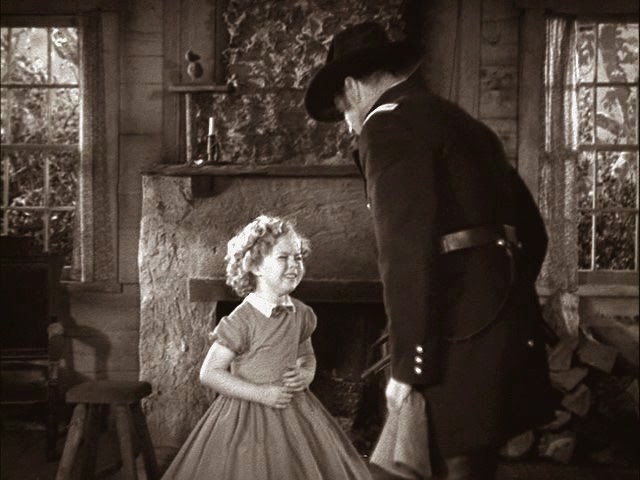
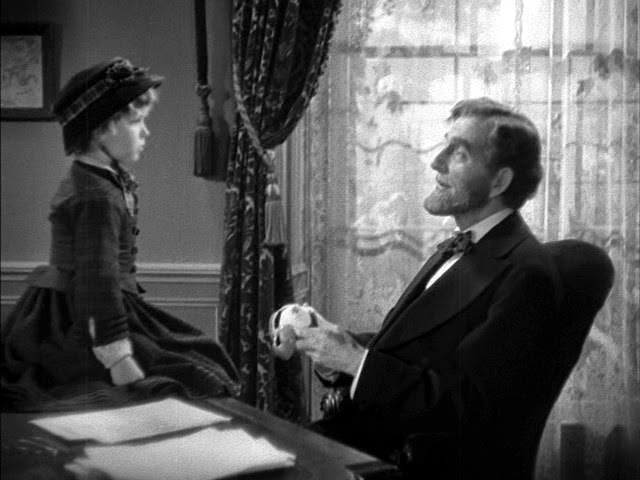
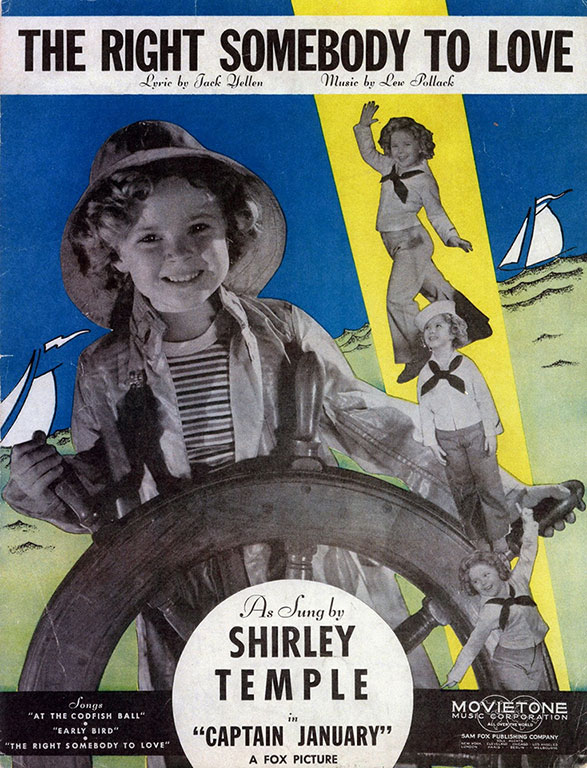 Captain January seems to have a special place in the hearts of Baby Boomers of a Certain Age, perhaps because it was one of Shirley Temple’s first features to go into television syndication in the 1950s. The source material was an 1891 novella by Laura E. Richards. Born Laura Elizabeth Howe in 1850, Mrs. Richards was the daughter of Julia Ward Howe, author of “The Battle Hymn of the Republic”. A prolific author in her own right, Mrs. Richards wrote over 90 books, including, with her sister Maud Howe Elliott, a biography of their mother that won them a Pulitzer Prize in 1917. Mrs. Richards also wrote the children’s nonsense poem “Eletelephony” (“Once there was an elephant,/Who tried to use the telephant –/No! No! I mean an elephone,/Who tried to use the telephone…”). Unlike the authors of The Little Colonel and The Littlest Rebel, she lived long enough to see two movies made from her modest little story, dying in 1943 at 92. Whether she saw either movie, or what she thought of them, is not recorded.
Captain January seems to have a special place in the hearts of Baby Boomers of a Certain Age, perhaps because it was one of Shirley Temple’s first features to go into television syndication in the 1950s. The source material was an 1891 novella by Laura E. Richards. Born Laura Elizabeth Howe in 1850, Mrs. Richards was the daughter of Julia Ward Howe, author of “The Battle Hymn of the Republic”. A prolific author in her own right, Mrs. Richards wrote over 90 books, including, with her sister Maud Howe Elliott, a biography of their mother that won them a Pulitzer Prize in 1917. Mrs. Richards also wrote the children’s nonsense poem “Eletelephony” (“Once there was an elephant,/Who tried to use the telephant –/No! No! I mean an elephone,/Who tried to use the telephone…”). Unlike the authors of The Little Colonel and The Littlest Rebel, she lived long enough to see two movies made from her modest little story, dying in 1943 at 92. Whether she saw either movie, or what she thought of them, is not recorded.
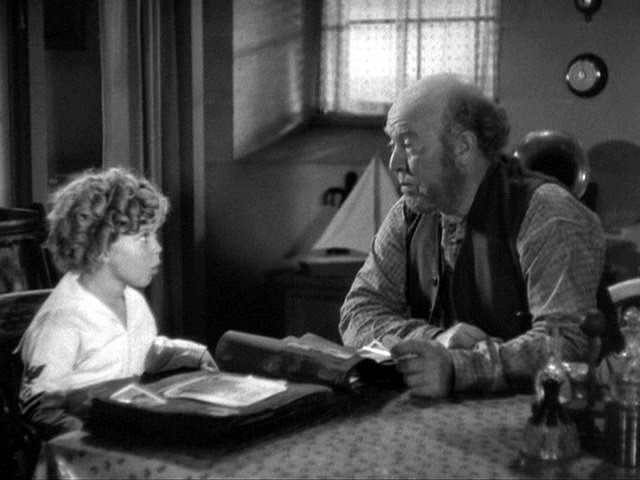



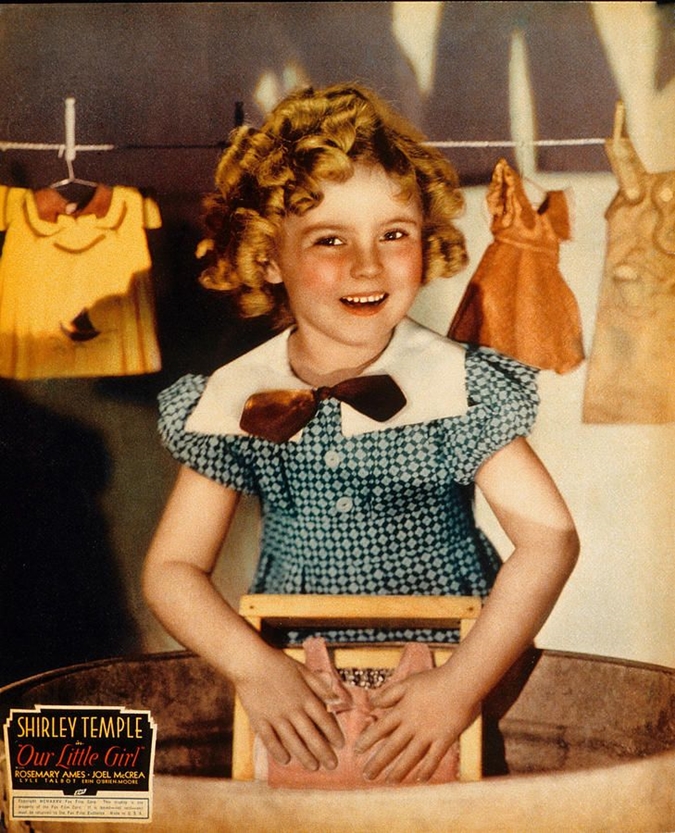 Our Little Girl
Our Little Girl  Curly Top
Curly Top 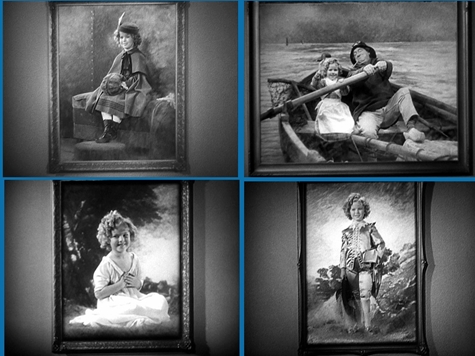 But like the story, the supporting players (Boles; Hudson; Jane Darwell and Rafaela Ottiano as matrons at the orphanage; Esther Dale as Boles’s aunt; Billy Gilbert and Arthur Treacher as his cook and butler) were all beside the point. Shirley was just about the whole show. She is even the focus of both Boles’s songs. After singing “It’s All So New to Me”, while the orchestra wafts on in the background, he strolls around his palatial drawing room, where he fancies Shirley beaming down at him from the paintings on the walls…
But like the story, the supporting players (Boles; Hudson; Jane Darwell and Rafaela Ottiano as matrons at the orphanage; Esther Dale as Boles’s aunt; Billy Gilbert and Arthur Treacher as his cook and butler) were all beside the point. Shirley was just about the whole show. She is even the focus of both Boles’s songs. After singing “It’s All So New to Me”, while the orchestra wafts on in the background, he strolls around his palatial drawing room, where he fancies Shirley beaming down at him from the paintings on the walls…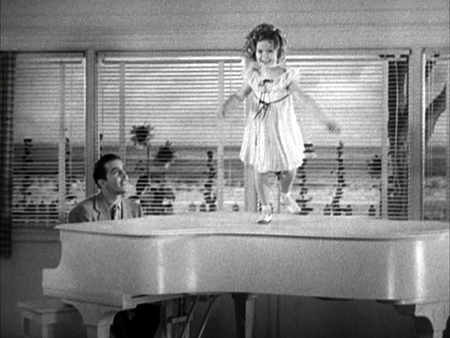

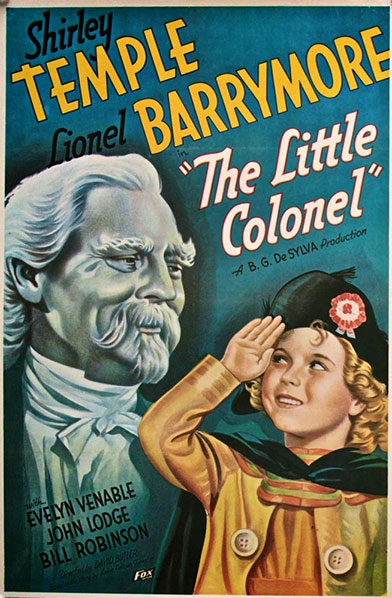 Shirley’s first picture of 1935 was a period piece, her first costume drama as a star. The source material was a children’s book by Annie Fellows Johnston of McCutchanville, Indiana. Mrs. Johnston turned to writing at the age of 29 when her husband died in 1892, leaving her with three small stepchildren to raise on her own. The Little Colonel, published in 1895, was her third novel, and it proved so popular that she wrote a sequel a year until 1907. She wrote, in all, some four dozen books before she died in 1931 at age 68, but The Little Colonel was the only one that was ever filmed. It’s a pity Mrs. Johnston couldn’t have hung on for four more years and seen the apotheosis of her most famous creation.
Shirley’s first picture of 1935 was a period piece, her first costume drama as a star. The source material was a children’s book by Annie Fellows Johnston of McCutchanville, Indiana. Mrs. Johnston turned to writing at the age of 29 when her husband died in 1892, leaving her with three small stepchildren to raise on her own. The Little Colonel, published in 1895, was her third novel, and it proved so popular that she wrote a sequel a year until 1907. She wrote, in all, some four dozen books before she died in 1931 at age 68, but The Little Colonel was the only one that was ever filmed. It’s a pity Mrs. Johnston couldn’t have hung on for four more years and seen the apotheosis of her most famous creation.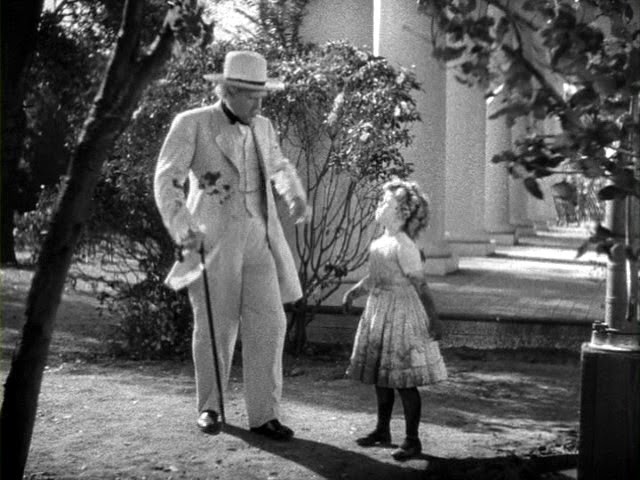
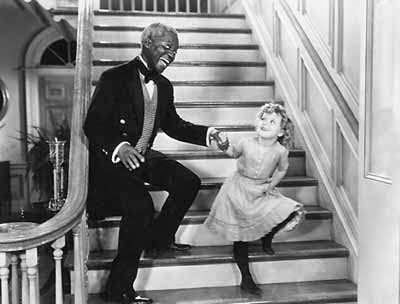
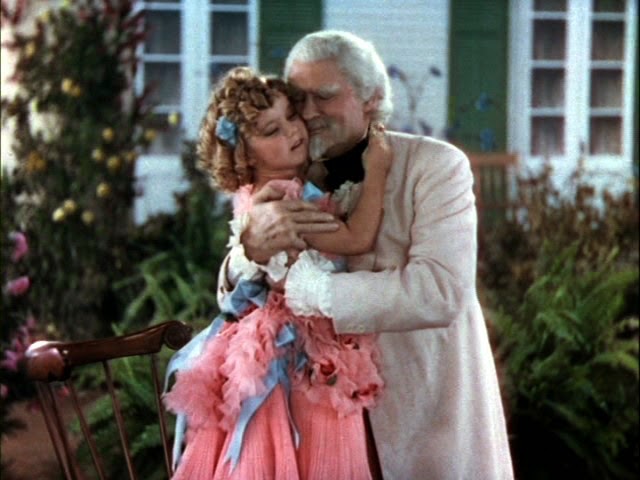

 In the mid-1950s Republic Pictures was on its last legs as a movie-producing entity. Formed in 1935, it was the brainchild of Herbert J. Yates, founder and president of Consolidated Film Industries, a film processing lab based in New York. Yates saw his big chance when six of Hollywood’s Poverty Row studios — the largest (relatively speaking) being Monogram and Mascot — became deeply indebted to Consolidated for processing fees. Yates called all their debts, then offered an alternative: merge into one production facility, with Yates as head of the studio. The others went for it, and Republic Pictures was born. (In 1937, unable to get along with Yates, Monogram’s officers backed out of the deal and reorganized under their old corporate name, which morphed in 1947 into Allied Artists.)
In the mid-1950s Republic Pictures was on its last legs as a movie-producing entity. Formed in 1935, it was the brainchild of Herbert J. Yates, founder and president of Consolidated Film Industries, a film processing lab based in New York. Yates saw his big chance when six of Hollywood’s Poverty Row studios — the largest (relatively speaking) being Monogram and Mascot — became deeply indebted to Consolidated for processing fees. Yates called all their debts, then offered an alternative: merge into one production facility, with Yates as head of the studio. The others went for it, and Republic Pictures was born. (In 1937, unable to get along with Yates, Monogram’s officers backed out of the deal and reorganized under their old corporate name, which morphed in 1947 into Allied Artists.)




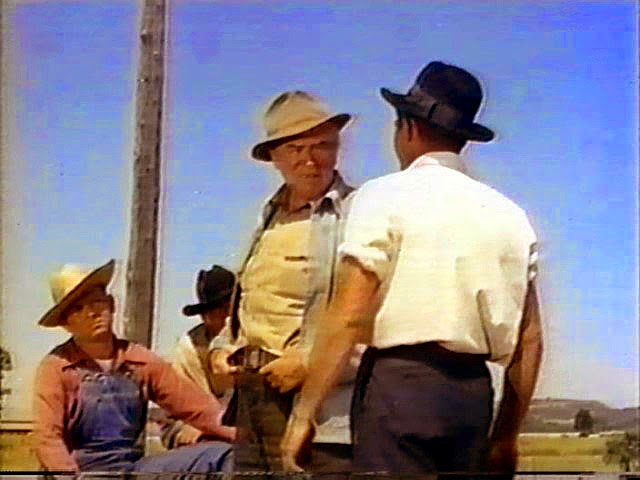
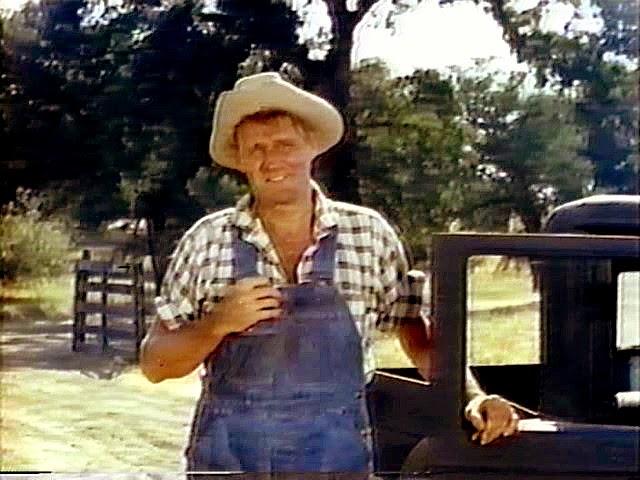

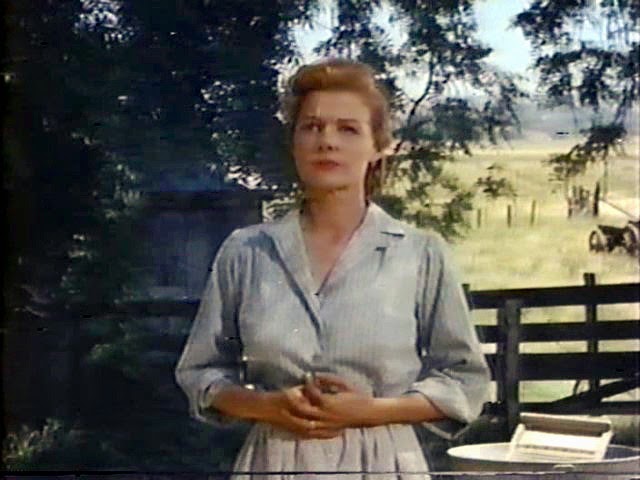
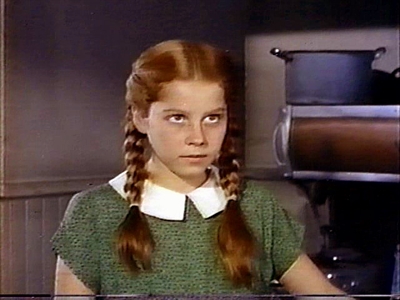 As if Ann Sheridan, and Steve Cochran, and Montgomery Pittman’s intelligent and perceptive script were not enough, there’s another excellent reason to see Come Next Spring, one that all by itself would be more than enough: the extraordinary performance of 13-year-old Sherry Jackson. If Pittman’s script was intended as a showcase for his friend Cochran, it seems to have been equally intended to give Pittman’s own stepdaughter the role of a lifetime. Even by the time Pittman married her mother in 1952, Sherry was already a veteran of more than 15 feature films. Mostly uncredited bits, but more substantial roles were ahead: one of the visionary Portuguese children in The Miracle of Our Lady of Fatima (’52), John Wayne’s daughter in Trouble Along the Way (’53). When shooting started on Come Next Spring, Sherry was coming off her second season as Danny Thomas’s oldest daughter on Make Room for Daddy.
As if Ann Sheridan, and Steve Cochran, and Montgomery Pittman’s intelligent and perceptive script were not enough, there’s another excellent reason to see Come Next Spring, one that all by itself would be more than enough: the extraordinary performance of 13-year-old Sherry Jackson. If Pittman’s script was intended as a showcase for his friend Cochran, it seems to have been equally intended to give Pittman’s own stepdaughter the role of a lifetime. Even by the time Pittman married her mother in 1952, Sherry was already a veteran of more than 15 feature films. Mostly uncredited bits, but more substantial roles were ahead: one of the visionary Portuguese children in The Miracle of Our Lady of Fatima (’52), John Wayne’s daughter in Trouble Along the Way (’53). When shooting started on Come Next Spring, Sherry was coming off her second season as Danny Thomas’s oldest daughter on Make Room for Daddy.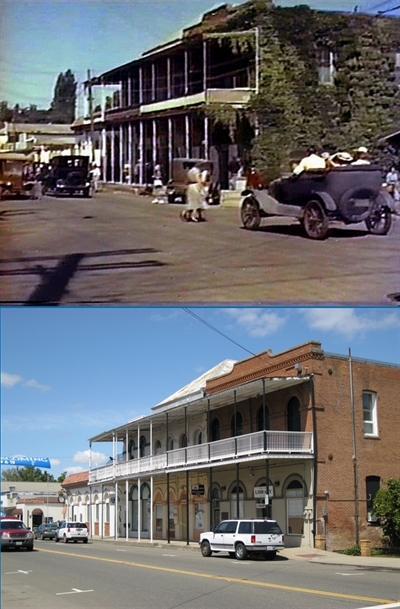
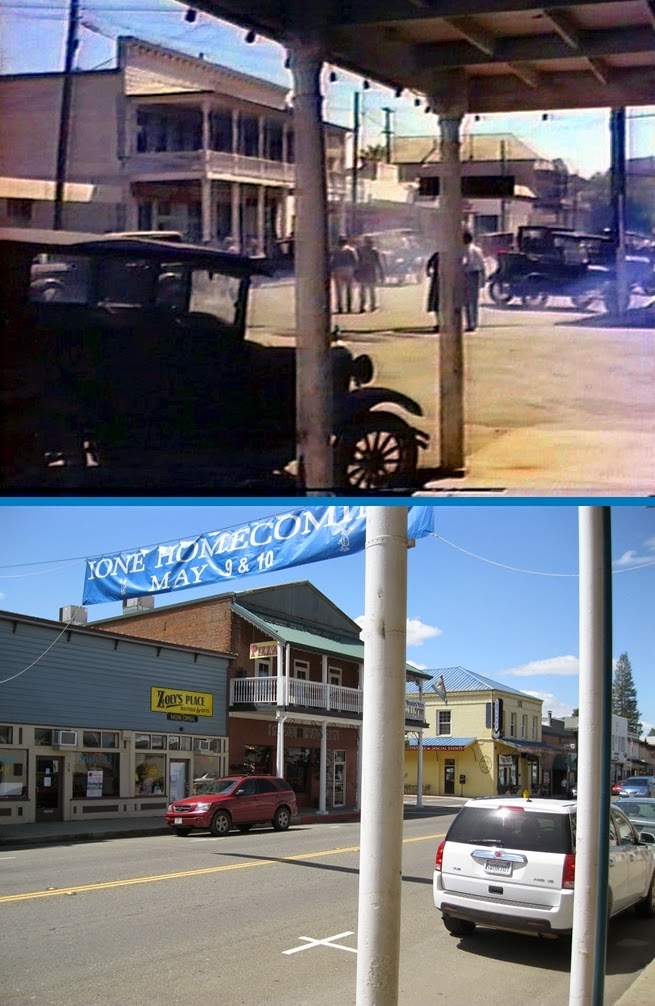
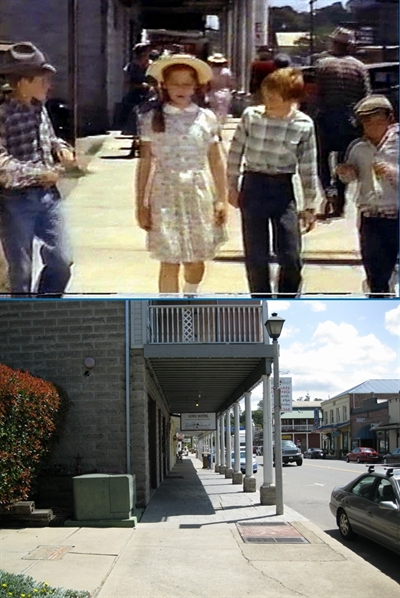

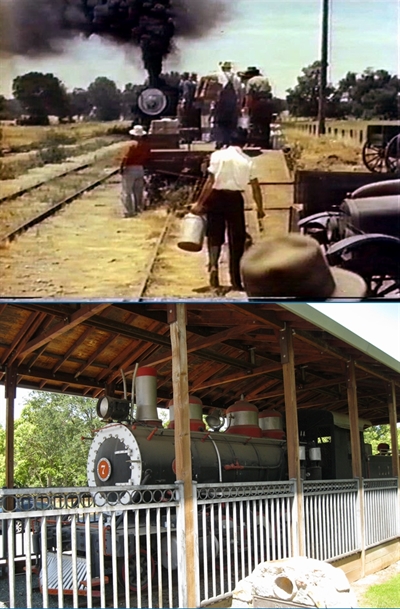


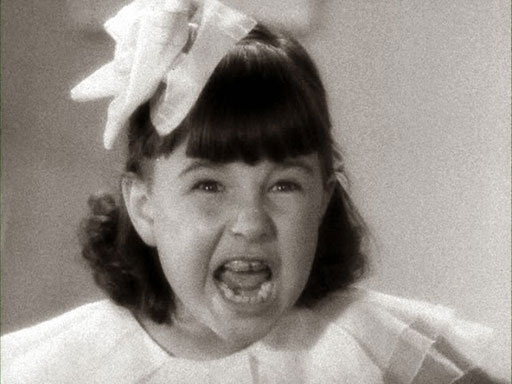 As bad as the Smythes are, they’re not the worst of it. That would be their daughter Joy (Jane Withers), a screaming little monster in a perpetual state of tantrum, and the most misnamed child in the history of human life on Earth.
As bad as the Smythes are, they’re not the worst of it. That would be their daughter Joy (Jane Withers), a screaming little monster in a perpetual state of tantrum, and the most misnamed child in the history of human life on Earth.
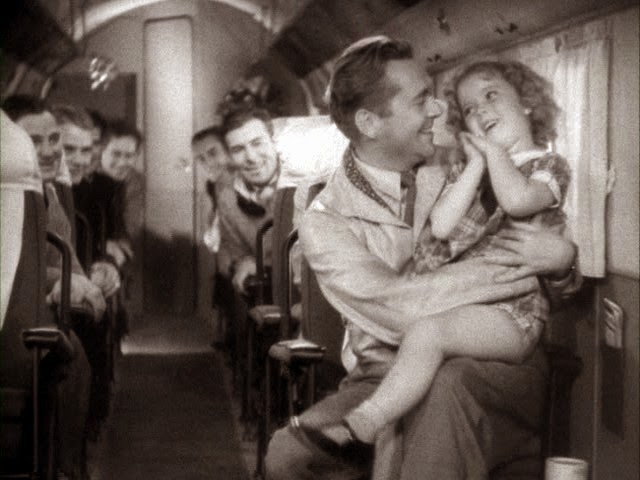


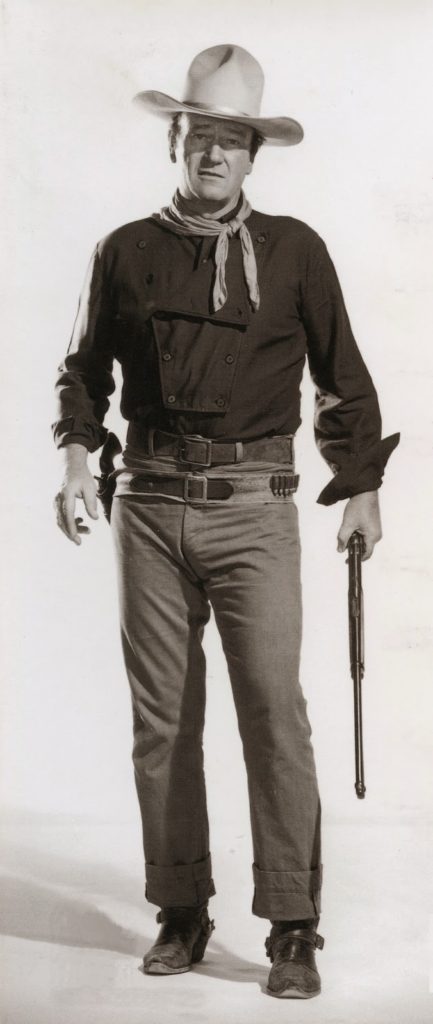
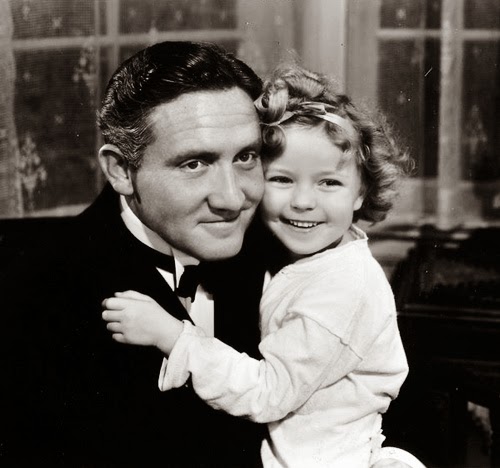
 First, an explanation of a trivial point, just so you don’t suspect sloppy copy editing here at Cinedrome. The title of Jay Gorney and Lew Brown’s song “Baby, Take a Bow” has a comma, and the comma appears in this and some other posters, ads and lobby cards for the movie. But it’s not on the picture’s main title card as it appears on screen. Therefore, I’ll be using the comma when referring to the song, but not using it when I’m referring to the movie. Got it?
First, an explanation of a trivial point, just so you don’t suspect sloppy copy editing here at Cinedrome. The title of Jay Gorney and Lew Brown’s song “Baby, Take a Bow” has a comma, and the comma appears in this and some other posters, ads and lobby cards for the movie. But it’s not on the picture’s main title card as it appears on screen. Therefore, I’ll be using the comma when referring to the song, but not using it when I’m referring to the movie. Got it?



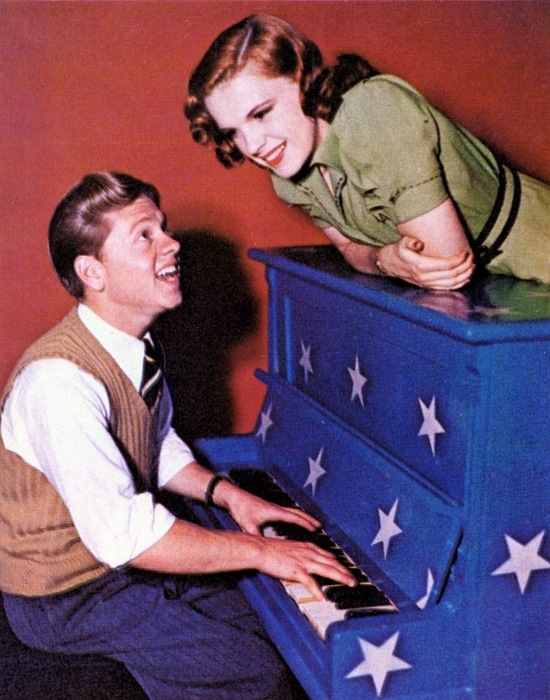 Another thread was broken this week that tied the 21st century to the Golden Age of Hollywood. This thread was a thick one, too. Unlike other child stars, including his contemporaries
Another thread was broken this week that tied the 21st century to the Golden Age of Hollywood. This thread was a thick one, too. Unlike other child stars, including his contemporaries 
